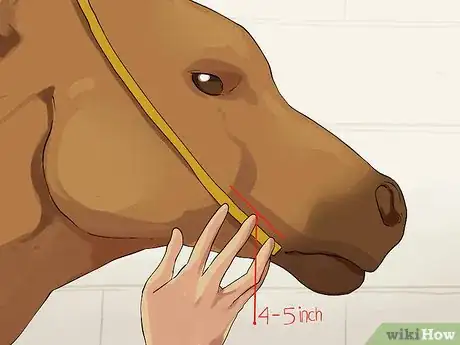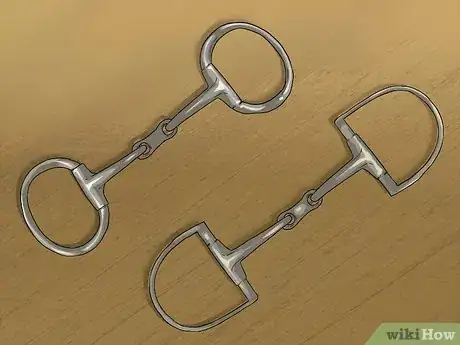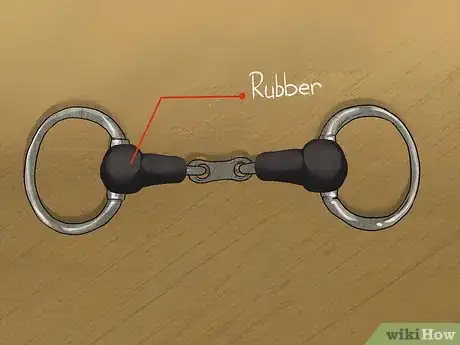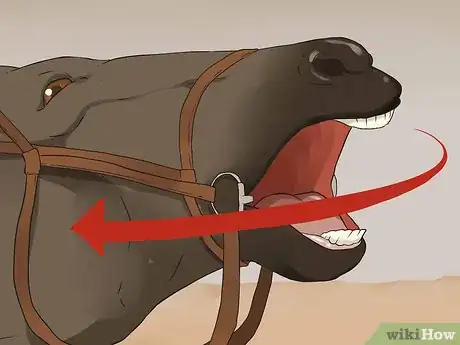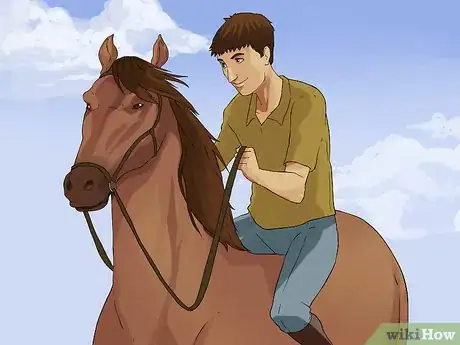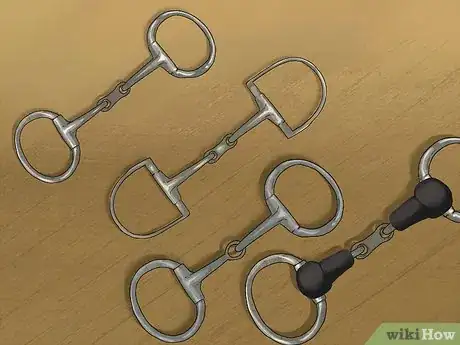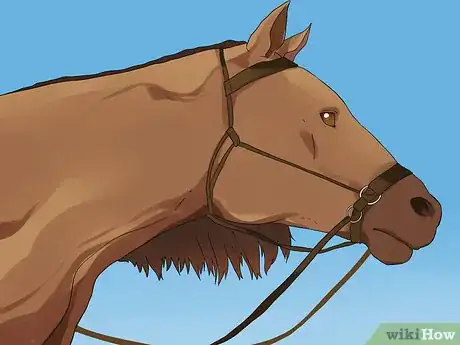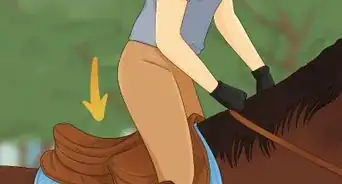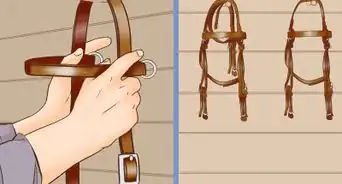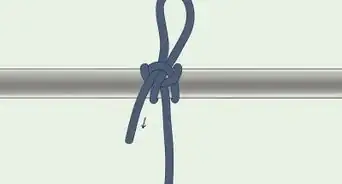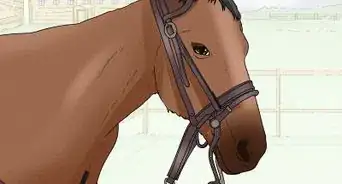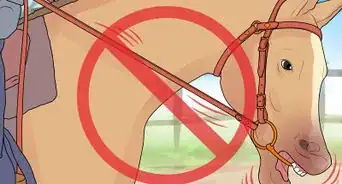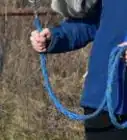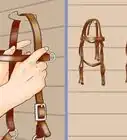This article was co-authored by Alana Silverman. Alana Silverman is a Certified EAGALA (Equine Assisted Growth and Learning Association) Equine Specialist and the Assistant Manager of Paddock Riding Club, a 200-horse premier equestrian facility based in Los Angeles, California. Alana has over 25 years of experience caring for and riding horses and specializes in English riding and riding instruction. She has a BA in Psychology from the University of Arizona.
This article has been viewed 229,692 times.
The general rule of choosing a bit is to find the mildest bit possible that still allows you to communicate clearly with your horse. An ill-fitting or overly severe bit can cause pain and discomfort to your horse, or even injure it. Take your time over this decision, and learn to use your new style of bit from an experienced mentor.
Steps
Choosing a Gentle Bit
-
1Check the requirements for horse shows. Most horse showing competitions forbid the use of certain bits. Even if you do not attend events, obeying one of these lists is not a bad idea. These bits are generally forbidden due to the pain they cause the horse.
-
2Start with a snaffle.[1] A simple snaffle bit is a mild, popular option, that only applies the amount of pressure you pull. Always begin with a snaffle, and try the stronger bits only if the horse is difficult to control.[2]Advertisement
-
3Measure the horse's mouth. You can purchase measuring tools for this purpose, or you can place a wooden dowel in his mouth where the bit should sit.[3] Find a dowel that sticks out about half an inch (1.25 cm) on either side; this dowel is the appropriate width for your bit.[4] For most horses, start with a 4–5 inch (10–13cm) bit and switch as necessary.
- Usually, a smaller horse has a smaller mouth and will need a smaller bit, and the reverse for larger horses. There are exceptions, however, as some breeds have unusually large or small heads.
- If you have access to a previous bit, allow it to hang straight and measure the mouthpiece. Do not include the rings in the measurement.
-
4Choose the ring shape. The outside of the snaffle consists of a ring on either side of the mouth. Common options include D-rings, O-rings, and loose rings which are free to rotate in place.[5] The best way to choose these is to try out several, to feel the difference in control and see how your horse reacts. Make your decision based on your and your horse's personal preference.
- If you can't try out the bit before buying, go with the popular D-ring. This tends to be less harsh than other bits, but be careful that the reins don't get caught in the corner.[6]
-
5Choose a mouthpiece. Snaffle bits come with a variety of mouthpieces as well. A basic, jointed mouthpiece is a good option for most riders, but there are other options.[7] Here are a few factors to keep in mind:
- Rubber or plastic-coated mouthpieces are more mild than a bare metal bar. Twisted wire mouthpieces are the most severe, and should only be used by experienced trainers.
- Thinner mouthpieces are generally more likely to cut the horse's mouth or cause pain.
-
6Check the mouthpiece comfort. Confirm that the mouthpiece is comfortable with the following tests:
- Make sure the rings or metal connections at the corners of the mouth do not pinch the horse's lip tissue. If you're not sure, put the side of your finger next to that ring/bar juncture. Spin the ring and see if it pinches your own finger (which is harder to pinch than soft tissue).
- The link in the middle of a "broken mouth snaffle" can pinch as well. If you have this type of bit, test this on the side of your finger as well.
- Check whether the center of the bit hits the rugae (ridges) of the horse's palate, or the roof of the mouth. This is often what's happening if the horse is restless or tosses its head a lot. In this case, switch to a French link mouthpiece, which lays flatter on the tongue and allows a larger range of motion.[8]
Choosing a Stronger Bit
-
1Decide whether a stronger bit is appropriate. Always train the horse with a mild snaffle bit before moving on to a more severe option. Stronger bits can provide more control, which may be useful for horse shows. Some excitable horses will resist stopping with a mild bit, but focus on ground work training first. Some spirited or sensitive horses will object to a harsh bit, and continue misbehaving.
- Think about your typical riding activities. You'll typically want a mild bit for riding in the school, and perhaps a stronger bit for more strenuous activity.
- Check the bit regulations of any horse competitions you plan to enter.
-
2Consider your own riding ability. Beginning riders are more likely to harm the horse with a strong bit. You should have a fair amount of riding experience before you try to use one.[9] Even then, ask your trainer for advice on choosing a bit, and on adjusting your rein use to adapt to a new bit.
-
3Choose the bit. There are many variations of bits, and you may need to try several before you find one that works. Most English riders just move to a snaffle with a harsher mouthpiece or ring. Western riders may try a different style of bit altogether, such as the curb bit. These use leverage to increase the amount of pressure from your pull. The Pelham and the Slotted Kimberwick are two common options which use a curb chain to provide more control over the head.
-
4Train the horse without a bit. Bitless riding is becoming more popular, although it is not yet legal in most competitions. Even if you use a harsh bit some of the time, consider training without a bit occasionally. This will improve your own balance and strength, and teach you to direct the horse with cues from the "seat." This may even solve some behavioral issues, as many horses calm down when the mouth is no longer agitated.
- Bitless riding is allowed in most jumpers, polo, and endurance competitions. For other disciplines, you will need to compete with a bit — but you may still benefit from the training.
Expert Q&A
-
QuestionWhat is the best bit to start a horse with?
 Alana SilvermanAlana Silverman is a Certified EAGALA (Equine Assisted Growth and Learning Association) Equine Specialist and the Assistant Manager of Paddock Riding Club, a 200-horse premier equestrian facility based in Los Angeles, California. Alana has over 25 years of experience caring for and riding horses and specializes in English riding and riding instruction. She has a BA in Psychology from the University of Arizona.
Alana SilvermanAlana Silverman is a Certified EAGALA (Equine Assisted Growth and Learning Association) Equine Specialist and the Assistant Manager of Paddock Riding Club, a 200-horse premier equestrian facility based in Los Angeles, California. Alana has over 25 years of experience caring for and riding horses and specializes in English riding and riding instruction. She has a BA in Psychology from the University of Arizona.
Certified Horse Trainer I like to start with a gentle bit, like a loose ring three-piece snaffle. The bit inside the horse's mouth can rotate around the rings on the side. For more stability, instead of rings the bit can have a D-ring shape or egg-butt. Please be careful that the reins do not get hooked onto the corner of the D-ring.
I like to start with a gentle bit, like a loose ring three-piece snaffle. The bit inside the horse's mouth can rotate around the rings on the side. For more stability, instead of rings the bit can have a D-ring shape or egg-butt. Please be careful that the reins do not get hooked onto the corner of the D-ring. -
QuestionI have an older horse that I ride with a hackamore, but she doesn't always respond. Should I go to a bit, or is she just acting up?
 Community AnswerIf she's never used a bit, it might not be a great idea to introduce one suddenly. Look into side-pulls or a bosal as potential bitless solutions. Also check to make sure the hackamore is correctly adjusted for her, as she might not respond if it is too loose and might act up if it is too tight.
Community AnswerIf she's never used a bit, it might not be a great idea to introduce one suddenly. Look into side-pulls or a bosal as potential bitless solutions. Also check to make sure the hackamore is correctly adjusted for her, as she might not respond if it is too loose and might act up if it is too tight. -
QuestionWhat is the best bit for young, new rider?
 Community AnswerStart with a snaffle -- beginners may hurt the horse with a stronger bit.
Community AnswerStart with a snaffle -- beginners may hurt the horse with a stronger bit.
Warnings
- Make sure all bits you choose are legal. This is especially important for any competitions or shows that you may wish to enter. There are many harsh bits that are illegal to use for some competitions and shows. Contact the governing body of your discipline for a rule book.⧼thumbs_response⧽
- If you are a beginner, do not get any complicated long shank bit. Improper use will rip up for horses mouth. Make sure you know how to use the bit before you put it on the horse.⧼thumbs_response⧽
- Don't ride your horse if it doesn't like its bit. Your horse may refuse to ride, and it is generally pointless to try to break it if the horse is uncomfortable.⧼thumbs_response⧽
- It is against horse show rules to have a curb chain on a regular egg butt or any other snaffle bit.⧼thumbs_response⧽
References
- ↑ Alana Silverman. Certified Equine Specialist. Expert Interview. 17 March 2020.
- ↑ https://www.horsejournals.com/riding-training/tack-gear/western/how-choose-right-bit
- ↑ Alana Silverman. Certified Equine Specialist. Expert Interview. 17 March 2020.
- ↑ https://www.youtube.com/watch?v=VcVUmosFD14
- ↑ http://extension.uga.edu/publications/detail.html?number=B1379&title=Bits%20101
- ↑ Alana Silverman. Certified Equine Specialist. Expert Interview. 17 March 2020.
- ↑ http://extension.uga.edu/publications/detail.html?number=B1379&title=Bits%20101
- ↑ http://www.equisearch.com/article/frenchlink-18439
- ↑ https://horseandrider.com/gear/picking-a-bit-for-trail-riding
About This Article
To choose a bit for your horse, try to find the gentlest bit possible that still lets you communicate clearly with your horse since too strong of a bit can cause pain and possibly injury. Start with a snaffle, which is a mild bit that only applies the amount of pressure that you pull, and then try stronger bits if you're still struggling to control your horse. To measure your horse for a bit, put wooden dowels in its mouth where the bit should sit. Once you find a dowel that sticks out 1/2 inch on each side, get a bit that's the same width. For tips on choosing a stronger bit for your horse, scroll down!



